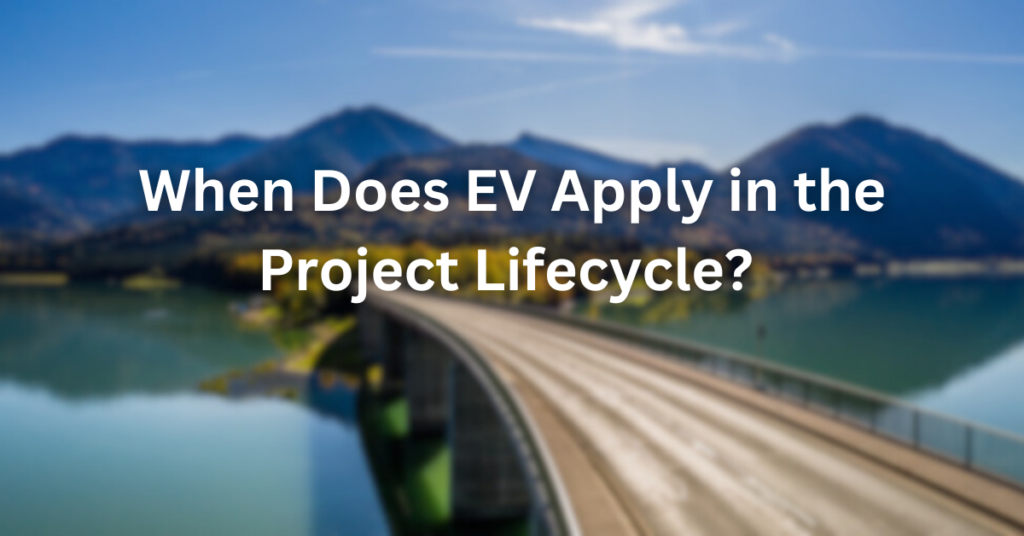When Does EV Apply in the Project Lifecycle?

Every project lifecycle includes key phases where we apply the EVM process. First, we will discuss the roadmap that takes us from applying EVM during the Pre-Contract Award through the Pre-Award or Post-Award Integrated Baseline Review (IBR):
Pre-Contract Award ➤ RFP / RFQ ➤ SRA ➤ IBR ➤ Contract Award ➤ Project Startup ➤ SRA ➤ IBR
Then we cover EVMS Compliance and Surveillance (routine compliance checks) during a project’s life cycle per this roadmap:
Compliance Review ➤ Internal Surveillance ➤ Joint Surveillance ➤ Subsequent Acceptance Review
Finally, we wrap up with the major planning events in a typical project plus more drastic event reviews that we all hope won’t occur in our projects as depicted in this roadmap:
Rolling Wave ➤ Replanning ➤ Reprogramming ➤ OTS ➤ OTB ➤ Review for Cause (RFC)
WHY USE EV DURING THE PRE-CONTRACT AWARD AND PROPOSAL PHASE?
The pre-contract award and proposal phase of a project can help contractors put their best foot forward, not only to win the contract but also to lay a solid foundation for the project phases that follow. This ultimately benefits all stakeholders. The following tips will help navigate this phase successfully:
- Pre-Award Integrated Master Schedule (IMS). The government doesn’t always require that project teams develop a comprehensive schedule during the proposal phase. As a result, many save this important task for later, but that is a grave mistake. A sound schedule not only can help create a winning proposal but also prepares for contract award when it’s time to begin work.
- Pre-Award Schedule Risk Assessment (SRA). The SRA tells us how likely we are to hit schedule targets and the likely (or unlikely) range of dates. Of course, you can’t conduct an SRA without a sound IMS.
- Pre-Award Integrated Baseline Review (IBR). Some RFPs / RFQs might include this review to help validate each competitor’s plan. This is an opportunity for contractors to give an early preview of their planning capability and EV maturity.
WHAT ARE THE BIG EV MILESTONES POST-CONTRACT AWARD (PROJECT STARTUP)?
After the contract award, it’s time for the project startup phase. This lasts about 30 to 90 days after the contract is awarded. The following strategies will ensure the success of the project during this important kickoff phase:
- Finalize the Team and Work Scope. Identify the all-important Control Account Managers (CAMs) for major chunks of work. Familiarize the project team with the scope, schedule, and cost targets. With everyone on the same page, refine the schedule that helped win the contract. Name owners for every SOW paragraph and major milestone.
- Help managers understand their work scope and then formally authorize that work with an agreed scope, schedule, and budget.
- Finalize the schedule. Add sufficient detail and integrate the IMS with other processes and data. Finalize the Work Breakdown Structure (WBS), issue work authorizations, and set up charge numbers. Develop the Integrated Master Plan (IMP) and the IMS (called IMP / IMS). These are key artifacts and finalizing them ASAP is crucial for project success.
HOW DO COMPLIANCE AND SURVEILLANCE CHANGE DURING THE PROJECT LIFECYCLE?
- EVMS Compliance. Subsequent compliance reviews look for organizational and project compliance issues and risks. It’s not enough to gain the initial EVMS certification. Contractors must stay compliant and may even have to re-demonstrate that their EVMS is compliant.
- EVMS Surveillance. After implementing an EVMS, we move into surveillance mode. Internal surveillance is performed by the contractor. External surveillance is when government reviewers, such as the Defense Contract Management Agency (DCMA) and DOE’s Office of Program Management (OPM) — among others – conduct yearly reviews on a sampling of organizations and projects. Government reviewers are transparent about the annual review schedule and which parts of the EVMS they will audit based on risk and other factors. For example, they might choose to focus on:
-
- Poor performing projects and often a mix of development, LRIP, and production projects.
- Known compliance risks from the prior year’s EV reporting.
- Pre-announced checks by EVMS process area or for a group of compliance metrics.
- Nunn-McCurdy Breach. When a DOD project significantly exceeds cost thresholds, it can trigger this requirement to investigate and can spur additional EVMS oversight, including a compliance review.
- Review for Cause (RFC). For both DOD and DOE projects, when scope, schedule, and cost targets or severe compliance issues arise, these can trigger an RFC which brings additional oversight reviews to help get the project back on track.
WHAT IS THE DIFFERENCE BETWEEN ROUTINE REPLANNING, REBASELINING THE PERFORMANCE MEASUREMENT BASELINE, AND REPROGRAMMING?
Rolling Wave Planning and Other Common Replanning
In an ideal world, the EV Performance Measurement Baseline (PMB) would never change. However, a robust EVMS plans for replans. Examples are Rolling Wave planning where the project team detail plans work up to a major program milestone, but keeps future work in larger chunks called planning packages. The EVMS must be flexible to deal with other common reasons to replan work such as the occasional error correction, replanning in-process work when things change mid-stream, and replanning unstarted work to represent a new reality–within contractual targets.
Major Replanning
When a significant program event impacts large chunks of work, the customer and contractor may agree that it’s better to replan the remaining work within the contractual SOW, schedule, and cost targets. Or there may be some contract modifications that need to get dialed into the performance measurement baseline.
Rebaselining
Debates arise over the term, but a common definition is a significant change in the plan that entails stepping back and claiming work complete in its tracks and replanning the remaining work within contractual targets. We’ll skip the details here regarding the nuanced process of replanning the performance measurement baseline.
Formal Reprogramming: Over-Target Schedule (OTS) and Over-Target Baseline (OTB)
When we start talking about OTS or OTB, we are now in the territory most projects hope to avoid. Here, the customer and contractor decide whether the schedule baseline has diverged too far from the contractual schedule target. The customer agrees to allow the contractor to replan the remaining work beyond the contractual PoP or contractual milestone or delivery dates – but within the contract value. With an OTB, both cost and schedule usually have to grow beyond the contract schedule and value; that is, the project’s baseline will now intentionally exceed the contractual targets.
WHAT HAPPENS DURING PROJECT CLOSEOUT?
As a project nears completion, EV data and reports lose their value. This makes sense given that the remaining work dwindles in the final months. Using judgment, the customer and contractor may decide that continued formal EV reporting is no longer meaningful, as the big surprises and risks are over.
Thus, there is a time when the project should consider waiving or tailoring the final EV reporting as the discrete program finish approaches.
Whether you’re a DOD or DOE agency or a contractor, navigating an EVM project doesn’t have to be stressful or intimidating. Download our free guide today! to demystify the process and provide the insights you need to achieve the outcome everyone in your organization expects.
Subscribe to our Newsletter:





